|
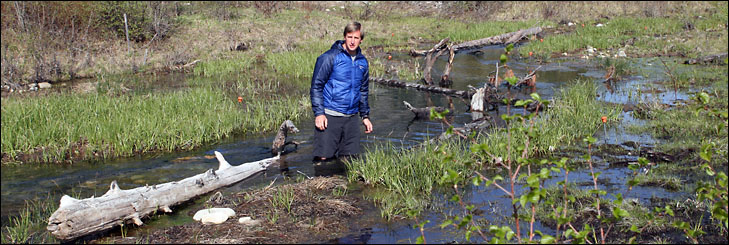 Yakama Nation fish biologist John Jorgensen is in charge of restoring Hancock Springs for fish habitat. Yakama Nation fish biologist John Jorgensen is in charge of restoring Hancock Springs for fish habitat.
Working Upstream
Hand-built habitat restoration
story and photos by Solveig Torvik
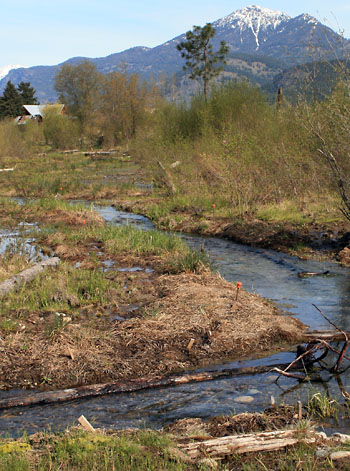 The source of Hancock Springs in Mamaza is the upwelling of water into the old Roy Kumm milk shed where the Kumm dairy's milk was kept cool.
John Jorgensen first noticed Hancock Springs while flying over Mazama in 2005. He quickly recognized that it was something special, even though the creek flowing out of the spring wasn’t much to look at.
Decades of cattle use had obliterated its banks, and the vegetation was all but gone. Only a few inches deep, it had spread out as much as 80 feet. It looked pretty much like the adjoining grazing field – except that water ran through it. No native fish lived in it.
Nonetheless, Jorgensen, 40, a fisheries biologist for the Yakama Nation, thought this was exactly the right place to try to restore endangered or threatened salmon, steelhead and bull trout.
But first he would have to restore the creek itself.
Few scientists shared his enthusiasm for this daunting experiment. Jorgensen realized he’d have to prove to doubters that Hancock Springs was worth the time, trouble and money. So, lacking funding for a more ambitious approach, he and a couple of helpers set to the backbreaking hand-work of showing what the creek could do. “The first thing I did was build a fence for 1 kilometer on one side,” says Jorgensen.
Meanwhile, between 2005 and 2011, the Methow Conservancy obtained conservation easements from the Allison family on 314 acres that included Hancock Springs and its creek, giving Jorgensen easier access to the site. But during the first two years he was not permitted - nor financially able - to bring in heavy equipment, so he and his helpers dragged mis-positioned logs out of the channel, brought in rocks to create weirs, designed spawning riffles and shoveled out pools. Most of this heavy lifting was done in 2006.
One year later, 23 steelhead redds (spawning beds) appeared in the area he had restored. “That was extremely fast,” says Jorgensen. At that point, roughly $100,000 of federal fisheries restoration monies had been spent on the Hancock Springs project, he estimates.
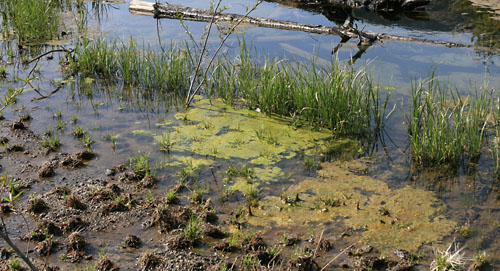 Fish and the insects they feed on are drawn to this restored habitat with algae, woody debris, and grasses.
Every year thereafter, fish have come to spawn in Hancock Creek, according to Jorgensen. In 2010, the first Chinook salmon arrived, building about 20 of the redds where fish typically deposit 1,000 eggs for fertilization. As of today, it’s been home to hundreds of juvenile steelhead and Spring Chinook salmon as well as the Piute Sculpin, a new sculpin species in the valley.
“We don’t know how many (juvenile) fish survive,” Jorgensen says; that’s what the tributary restoration experiment is all about, after all. But he thinks both wild and hatchery fish have found their way to Hancock Creek. And if the wild and hatchery fish mate, their offspring are considered wild fish, he notes.
The restoration work to make Hancock Creek fish friendly is far from finished. Nearly seven years on, about a third of the work has been done, Jorgensen estimates. But the lovely, winding creek now runs four to six feet wide and varies in depth from a few inches to several feet. The restoration work has gone about 1,000 feet downstream, with roughly 2,000 more feet to go before it reaches the Methow River.
Jorgensen is the first to admit that it’s too early to tell how successful his experiment ultimately will be, though the early indicators seem to suggest that the living laboratory that is Hancock Springs may prove to be well worth the trouble. In any case, says Jorgensen, it will tell other scientists if such intensive habitat intervention in the Columbia’s tributaries can be successful.
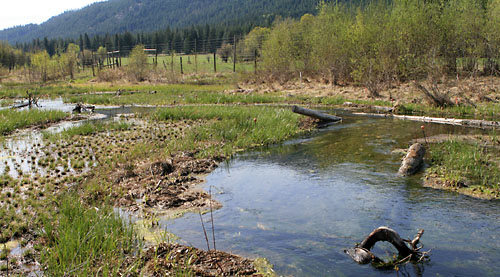 Hancock Springs has been restored to its original winding, s-curve channels. On the left, are some of the 60,000 plugs of sedge grass and other native vegetation cultivated in mats and hand-planted along the channel.
When it was clear that Jorgensen had succeeded in luring fish into the creek, previously dubious funding entities, as well government permitting agencies, sat up and took notice. Permits to use heavy equipment were issued and money became available for intensive restoration. Detailed engineering design and hydrological studies followed, as did the big rigs to move sediment and pour fill along the streamside where banks used to be. A thousand feet of deer fence was erected along the creek banks, which originally were higher than they are now, but the amount of fill needed to fully restore them was financially prohibitive, Jorgensen says.
So far, 300 small-diameter logs have been added to the creek, as have 2,000 yards of fill - blown in through a pipe from 100 feet away to avoid wrecking the banks - and a couple of hundred yards of spawning gravel. Sixty thousand individual plugs of sedge grass have been hand-planted. In addition, 800 fiber mats measuring 1 x 5 meters containing tiny starts of native vegetation such as bull rush have been laid along the banks. Hundreds of trees raised in one-gallon pots by local nursery Methow Natives – birch, aspen, willows, cottonwood – also have been planted. “We increased the sinuosity,” of the creek, Jorgensen says, which changed how the water’s energy is expended as it travels downhill.
The cost of the work so far is about $400,000, says Jorgensen, paid for by federal taxpayer funds, the Bonneville Power Administration’s ratepayers and the state. The U.S. Fish and Wildlife Service and tribal staff did most of the work themselves in-house rather than calling in private contractors, Jorgensen says, and that helped keep costs in check.
Hancock Springs’ water comes from a unique place. It still flows up through the “floor” of the old Kumm dairy’s milk house, where milk was kept cool by the spring water, then runs gently downhill for one kilometer to marry up with the Methow River.
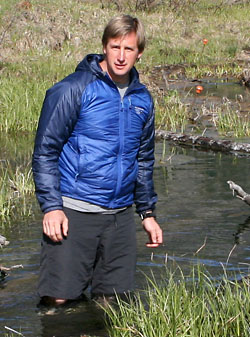 John Jorgensen says this particular stream is unique in the Methow Valley because of its slow-running, low gradient which can lead to nutrients important to fish.
By way of contrasting example for fish restoration projects, Jorgensen says, “You can only do so much with Lost River. It’s cool, it’s clear, but you can only do so much with it.” But a lot can be done with Hancock Springs, as it turns out.
The creek is unique in the valley because of its slow-running, low gradient, says Jorgensen. This enhances its potential to become biologically rich in nutrients needed by fish, and one of his goals is to plant vegetation that attracts lots of insects to the creek.
It’s sometimes an overlooked component of fish restoration, but Jorgensen says he’s a strong believer in the importance of making sure fish have enough food. So salmon carcasses or fish pellets will be added to the creek, mimicking what happens naturally in spawning beds. Non-native brook trout will be removed. And pit-tagging of fish has begun; these tiny electronic transponder tracking devices will help tell the story of what becomes of them as - or if - they survive to pass McNary Dam’s reading station on the Columbia’s mainstem.
How can he tell if all this work is making a difference to the fish? “This far we are seeing a larger percentage of fish spawning and rearing in the restored part of the spring than in the (un-restored) reach below it,” Jorgensen answers.
But he stresses that it’s vital to assess the effectiveness of the restoration over time rather than just restore the area and walk away from it. What’s going on at Hancock Springs will bear close watching for years to come. The question to be answered, says Jorgensen, is “Do these types of intervention really work?”
The important thing to keep in mind when judging the efficacy of human intervention in Columbia River tributaries such as Hancock Springs, says Jorgensen, is not just counting the number of spawners that show up. What will matter, he says, is how many fish make it out of Hancock Creek into the Methow River to enter the Columbia en route to the sea.
5/14/2012
|
